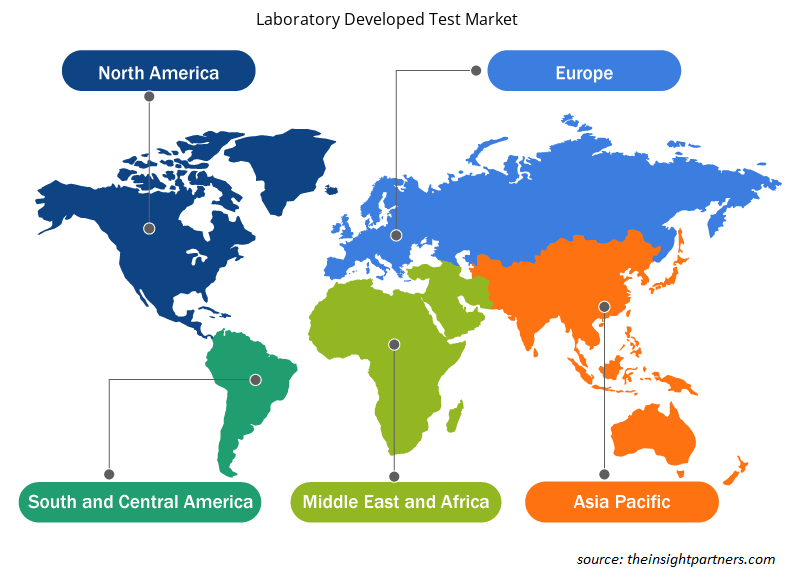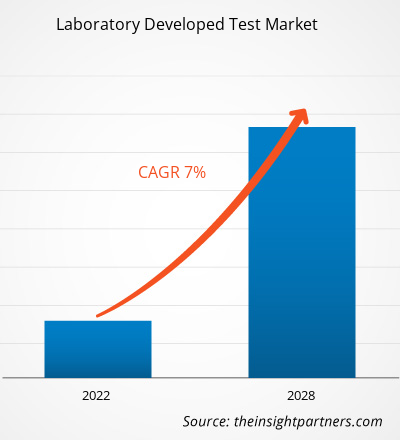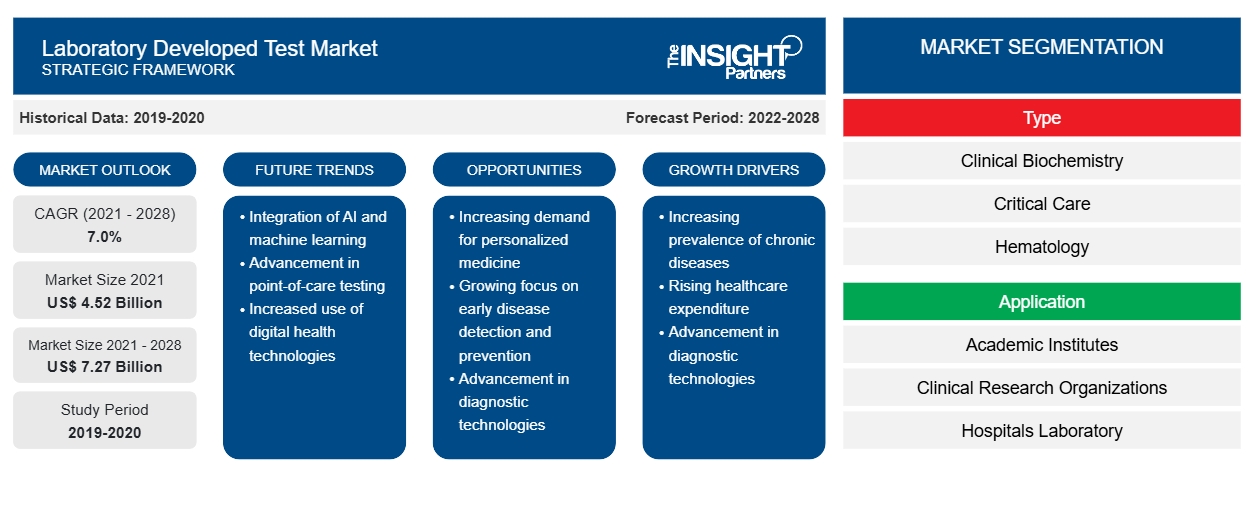ラボ開発テスト市場は、2021年の45億2,475万米ドルから2028年には72億6,930万米ドルに達すると予想されており、2021年から2028年にかけて7.0%のCAGRで成長すると予想されています。
ラボ開発テスト (LDT) は、単一のラボ内で設計および使用される体外診断テストの一種です。これらのテストは、人間の被験者から収集された検体から抽出されたタンパク質、生体分子/化合物 (グルコース、コレステロールなど)、DNA などの分析対象物を推定または区別するために使用できます。ラボや薬局で正確でエラーのない分析を行うための自動化された体外診断 (IVD) 方法の拡大は、ラボ開発テスト市場の成長を促進しています。
臨床検査市場の成長は、主にがんや遺伝性疾患の発生率の増加、製品の大量発売などの要因によるものです。しかし、規制環境の変化が市場の成長を妨げています。たとえば、欧州では、2022年5月からすべての体外診断検査で体外診断デバイス規制(IVDR)の遵守が義務付けられます。この規制は、医療検査の臨床的有効性と安全性を確保することを目的としており、診断業界を変革することになり、市場関係者にとって大きな懸念事項となっています。
要件に合わせてレポートをカスタマイズする
このレポートの一部、国レベルの分析、Excelデータパックなど、あらゆるレポートを無料でカスタマイズできます。また、スタートアップや大学向けのお得なオファーや割引もご利用いただけます。
-
このレポートの主要な市場動向を入手してください。この無料サンプルには、市場動向から見積もりや予測に至るまでのデータ分析が含まれます。
市場分析
パーソナライズ医療に関する継続的な研究は、臨床検査市場のプレーヤーに成長の機会を提供します
LDT は、効果的な治療法や治療法がまだ見つかっていない病気に取り組む有望な手段として証明される可能性が高いパーソナライズド メディシンの開発において重要な役割を果たしています。パーソナライズド メディシン連合によると、パーソナライズド メディシンは 2005 年に FDA が新たに承認した分子実体のわずか 5% を占めていましたが、2016 年にはこの数字は 25% 以上に増加しました。さらに、パイプラインにある全化合物の 42% と腫瘍学化合物の 73% は、パーソナライズド メディシンとして機能する可能性があります。バイオ医薬品企業は、過去 5 年間でパーソナライズド メディシンへの研究開発投資をほぼ 2 倍に増やしており、今後 5 年間でさらに 33% の投資増加が見込まれています。バイオ医薬品の研究者は、今後 5 年間でパーソナライズド メディシンの開発が 69% 増加すると予測しています。臨床検査は、病気の診断や薬物反応の予測と監視、および複雑な予測アルゴリズムに必要な情報データの取得に使用されます。 play a vital role in the development of personalized medicines that are likely to prove as promising means of tackling diseases through far eluded effective treatments or cures. As per the Personalized Medicine Coalition, personalized medicines accounted for only 5% of the new FDA-approved molecular entities in 2005; however, in 2016, this number rose to more than 25%. Additionally, 42% of all compounds and 73% of oncology compounds in the pipeline have the potential to serve as personalized medicines. Biopharmaceutical companies have nearly doubled their R&D investments in personalized drugs in the last five years, and they are further expected to increase their investments by 33% in the next five years. Biopharmaceutical researchers also predict a 69% increase in the development of personalized medicines in the next five years. Laboratory tests are used to diagnose illness and predict and monitor drug response as well as to obtain informatics data needed for complex predictive algorithms.
パーソナライズされた医薬品は、がん治療のトレードマークになりつつあります。これは、個人の遺伝子構成に応じて治療をカスタマイズすることに基づく、常に進化するアプローチです。2019年、FDAは病気の根本原因を調査して対処するための12のパーソナライズされた医薬品を承認し、臨床ケアに精密医療を統合しました。パーソナライズされた医薬品の需要の高まりは、ラボ開発テスト市場で活動するプレーヤーの成長に大きな成長機会を提供しています。
タイプベースの洞察
臨床検査市場は、タイプ別に、臨床生化学、救命医療、血液学、微生物学、分子診断、免疫学、その他に分類されています。分子診断セグメントは、2021年に市場で最大のシェアを占めると予想されています。ただし、予測期間中、血液学セグメントは市場で最も高いCAGRを記録すると予想されています。CAGR in the market during the forecast period.
アプリケーションベースの洞察
アプリケーション別に見ると、検査室は学術機関、臨床研究機関、病院の検査室、専門診断センターなどにテスト市場のアプリケーションを展開しています。病院の検査室セグメントは、2021年に最大の市場シェアを占めると予測されています。ただし、専門診断センターセグメントは、予測期間中に市場で最も高いCAGRを記録すると予想されています。CAGR in the market during the forecast period.
製品の発売と承認は、企業が世界的な足跡と製品ポートフォリオを拡大するために一般的に採用されている戦略です。さらに、ラボ開発テスト市場のプレーヤーは、顧客を拡大するためのパートナーシップ戦略に重点を置いており、これにより、ブランド名を世界的に維持することができます。
このレポートでは、実験室開発テスト市場を以下のように分類しています。
タイプに基づいて、ラボ開発テスト市場は、臨床生化学、救命救急、血液学、微生物学、分子診断、免疫学、その他に分類されます。アプリケーションに基づいて、ラボ開発テスト市場は、学術機関、臨床研究組織、病院の検査室、専門診断センター、その他に分類されます。地理に基づいて、ラボ開発テスト市場は、北米(米国、カナダ、メキシコ)、ヨーロッパ(英国、ドイツ、フランス、イタリア、スペイン、その他のヨーロッパ)、アジア太平洋(中国、日本、インド、オーストラリア、韓国、その他のアジア太平洋)、中東およびアフリカ(UAE、サウジアラビア、南アフリカ、その他の中東およびアフリカ)、南米および中米(ブラジル、アルゼンチン、その他の中南米)に分類されます。
ラボ開発テスト市場の地域別分析
予測期間を通じてラボ開発テスト市場に影響を与える地域的な傾向と要因は、Insight Partners のアナリストによって徹底的に説明されています。このセクションでは、北米、ヨーロッパ、アジア太平洋、中東、アフリカ、南米、中米にわたるラボ開発テスト市場のセグメントと地理についても説明します。

- 臨床検査市場に関する地域別データを入手
ラボ開発テスト市場レポートの範囲
| レポート属性 | 詳細 |
|---|---|
| 2021年の市場規模 | 45億2千万米ドル |
| 2028年までの市場規模 | 72億7千万米ドル |
| 世界のCAGR(2021年~2028年) | 7.0% |
| 履歴データ | 2019-2020 |
| 予測期間 | 2022-2028 |
| 対象セグメント |
タイプ別
|
| 対象地域と国 |
北米
|
| 市場リーダーと主要企業プロフィール |
|
ラボ開発テスト市場のプレーヤー密度:ビジネスダイナミクスへの影響を理解する
研究室開発テスト市場は、消費者の嗜好の変化、技術の進歩、製品の利点に対する認識の高まりなどの要因により、エンドユーザーの需要が高まり、急速に成長しています。需要が高まるにつれて、企業は提供を拡大し、消費者のニーズを満たすために革新し、新たなトレンドを活用し、市場の成長をさらに促進しています。
市場プレーヤー密度とは、特定の市場または業界内で活動している企業または会社の分布を指します。これは、特定の市場スペースに、その規模または総市場価値と比較して、どれだけの競合相手 (市場プレーヤー) が存在するかを示します。
ラボ開発テスト市場で事業を展開している主要企業は次のとおりです。
- クエスト・ダイアグノスティクス株式会社
- F. ホフマン・ラ・ロッシュ株式会社
- キアゲン
- イルミナ株式会社
- ユーロフィンサイエンティフィック
免責事項:上記の企業は、特定の順序でランク付けされていません。

- ラボ開発テスト市場のトップキープレーヤーの概要を入手
企業プロフィール
- クエスト・ダイアグノスティクス株式会社
- F. ホフマン・ラ・ロッシュ株式会社
- キアゲン
- イルミナ株式会社
- ユーロフィンサイエンティフィック
- バイオデシックス
- 適応型バイオテクノロジー
- バイオセラノスティクス
- ロゼッタ・ジェノミクス株式会社
- ガーダントヘルス
- 過去2年間の分析、基準年、CAGRによる予測(7年間)
- PEST分析とSWOT分析
- 市場規模価値/数量 - 世界、地域、国
- 業界と競争環境
- Excel データセット
最新レポート
お客様の声
購入理由
- 情報に基づいた意思決定
- 市場動向の理解
- 競合分析
- 顧客インサイト
- 市場予測
- リスク軽減
- 戦略計画
- 投資の正当性
- 新興市場の特定
- マーケティング戦略の強化
- 業務効率の向上
- 規制動向への対応























 無料サンプルを入手 - ラボ開発テスト市場
無料サンプルを入手 - ラボ開発テスト市場